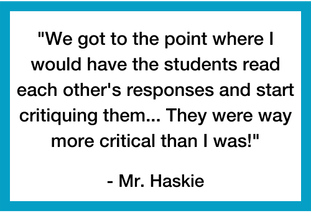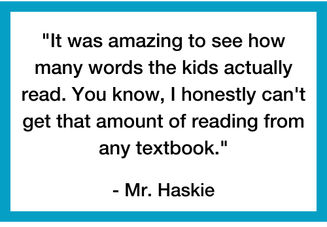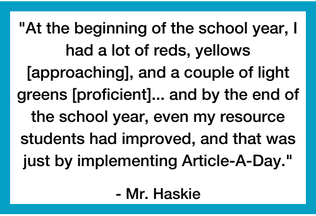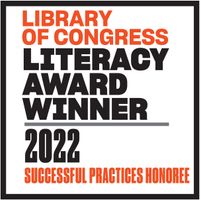|
A sixth-grade Navajo educator, Mr. Leon Haskie, implemented Article-A-Day in his classroom for eight months, from September 2021 to May 2022. At Haskie’s school, Atsá Biyáázh Community School in New Mexico, over 90% of the students are connected to the Navajo tribe, and the other students are mixed with Navajo and another tribe. The school-wide ELA program is Journeys. The school also has monthly testing to measure student trends of success in each standard across reading, science, and math. In light of the impact of COVID-19 on student learning and the school’s shift to remote learning, Haskie started implementing Readworks, and more specifically Article-A-Day, as a digital supplement. He had the following goals for using Article-A-Day:
Haskie implemented Article-A-Day as a 10-minute bell ringer five days a week at the onset of class. Students picked an article of their choosing from the week’s Article-A-Day set. Once students had read their articles for that day and written in their Books of Knowledge, Haskie would call on random students to present what they learned from the Books of Knowledge. On some days, he also had students peer review other student's work, which took three to 10 additional minutes. Haskie found that this peer work led to greater student engagement. Haskie graded Article-A-Day as 20 points per article for a total of 100 points per week. For any additional articles students read outside of the required bell ringer, he gave them five extra points. We conducted a 30-minute interview with Haskie on July 27th, 2022. In this interview, we hoped to investigate two questions about Article-A-Day implementation:
After the interview, we transcribed and coded the transcript for themes to help us dig into our questions about the impact of Article-A-Day. Findings Haskie’s implementation of Article-A-Day produced many clear benefits. First, he found that student engagement increased in the virtual classroom setting. Second, he found that students’ reading and writing production both increased. Third, he also found that students improved on their monthly standardized testing by large percentages. Finally, through all of his success with Article-A-Day, his school asked him to lead a training to support implementing Article-A-Day schoolwide.  Finding #1: Increased Student Engagement Haskie implemented Article A-Day as a nonnegotiable in his classroom, which ensured that all students fully participated even with the challenge of virtual learning. After completion of Article-A-Day each day, he checked their work for the grade, and then the students began to join in on the review. He said, “We got to the point where I would have the students read each other's responses and start critiquing them. The students would say, ‘That's not a complete sentence’ etc. They were way more critical than I was!” This peer review engaged the students tremendously, so Haskie sought to implement new strategies to maintain this engagement but lessen the extra time it took: “I did not do every single student during a peer review. I had this program where I could select a random student. The students didn't know who was going to be drawn, so they were all responsible because they didn't want to be that child who didn't write down anything.” As this process continued, instead of feeling anxious about being called next, the students began volunteering themselves. This surprised Haskie: “At first, they were like, ‘Oh, I hope I don't get drawn.’ But as we started progressing throughout the year, I started to see that they would actually volunteer their work to be showcased.” This excitement about Article-A-Day, peer review, and being called on was evidence to Haskie of his students’ increased engagement.  Finding #2: Increased Reading and Writing Adding on to the student's willingness to engage, Haskie also observed a noticeable increase in the amount students read and wrote. Haskie and the students could see, through Readworks’ word tracker report, how much more reading was happening. Both Haskie and his students were surprised at the amount that they were reading. Haskie said, “At first, the tracker read 100,000 words and then 150,000 words – you know, they were just surprised. It was amazing to see how many words the kids actually read. You know, I honestly can't get that amount of reading from any textbook.” Even the administration at Haskie’s school took notice of the increase in reading and asked Haskie how he got students to read so many words. When he explained that Article-A-Day had been used as a bell ringer and a supplement to their Journeys program, the school asked him to train other teachers on Article-A-Day so that the school, starting September 2022, could begin a school-wide adoption of Article-A-Day. Beyond the increase in the quantity of reading, Haskie also observed an increase in writing. He challenged his students to write throughout the year. He described his method as, “I started out with plain and simple. I was happy when they answered, that's all I cared about. That went on for like a good month. Then I increased it to wanting to see complete sentences. I kept that going for like 3 or 4 months. Then I increased the rigor. I expected them to cite from the article they read that day.” As he kept this up, the students began to write at more and at more complex levels. The teacher explicitly noted that, though his goal was to increase reading and engagement, he “saw the students’ growth in writing just from reading.” He attributed this to the simultaneous act of reading and writing about their experiences from the text.  Finding #3: Improved Standardized Test Scores Haskie also observed improvement in students’ standardized test scores. Haskie did not shy away from explaining what he felt contributed to the improvement in scores for the students: “At the beginning of the school year, I had a lot of reds, yellows [Approaching], and a couple of light greens [proficient]. Dark green would be a highly proficient student. Then we progress-monitored, and by the end of the school year, even my resource students had improved, and that was just by implementing Article-A-Day.” According to Haskie, regular implementation of Article-A-Day was a key part of his students’ improved standardized test scores. Conclusion In this exploratory case study, we set out to understand the impact of one teacher using Article-A-Day regularly over an extended period of time, and we saw clear successes and benefits. Through Article-A-Day, students were more engaged which led to an increase in reading and writing on a personal level. On a systemic level, the administration saw improvements in this specific teacher's standardized test scores due at least in part to the implementation of Article-A-Day and are now implementing Article-A-Day school-wide. This shows that the implementation of Article-A-Day by an individual teacher can positively impact students’ academic and personal growth, help shift classroom culture, and ultimately inspire an all-school implementation. Written by:
Serena Bradshaw, Research Specialist Susanne Nobles, Ph.D., Chief Academic Officer
1 Comment
10/18/2022 12:01:47 pm
I was impressed with the writing success. What a wonderful extension to their reading. So many adult learners and 8 to 12 learners are such poor writers. It's an extension of their reading comprehension. Thanks!
Reply
Leave a Reply. |
Categories
All
Archives
July 2024
|
















